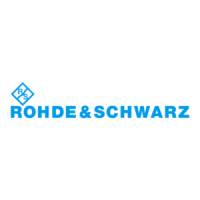GUI reference
R&S
®
ZNA
332User Manual 1178.6462.02 ─ 20
Set the "Input Power" to a value in the linear region of the DUT. A good starting point is
approximately 10 dB below the 0.1 dB input compression point of the DUT.
Result Settings
In the "Result Settings" section, you can specify the trace noise of the NF measure-
ment trace. Select a predefined value or enter a custom trace noise. The proposed
value is based on the previously specified DUT Settings.
Furthermore, the "Result Settings" section displays the required measurement time to
achieve the user selected (or entered) trace noise for the NF measurement trace. This
information is calculated based on the selected Meas Settings and the VNA character-
istics. If the current configuration of the VNA can be optimized to achieve faster mea-
surement times, the required steps for optimization are shown in the info box.
The recommended setup considers the achievable measurement time and the effort to
reconfigure the R&S ZNA. The intention of the algorithm is to recommend a reasonably
fast measurement, with minimum effort in terms of changing the Direct generator/
receiver access and/or Direct source monitor access jumpering. Changing the jumper
configuration can be advantageous for low source power levels (direct source monitor
access at driving port), or to improve the receiver noise figure (Reverse Coupler Con-
figuration at receiving port).
More Information opens an overview of the measurement times for all possible VNA
configurations.
More Information ← Result Settings
Opens a dialog that displays the calculated measurement time for the setup variants
that are possible with the relevant VNA hardware (Direct source monitor access,
Reverse Coupler Configuration, Internal low noise preamplifier), if equipped. The
resulting measurement times are based on the VNA characteristics, and the Meas Set-
tings and DUT Settings configured in the "Quickset" dialog. Modify these settings to
achieve a reasonable measurement time.
Meas softtool

